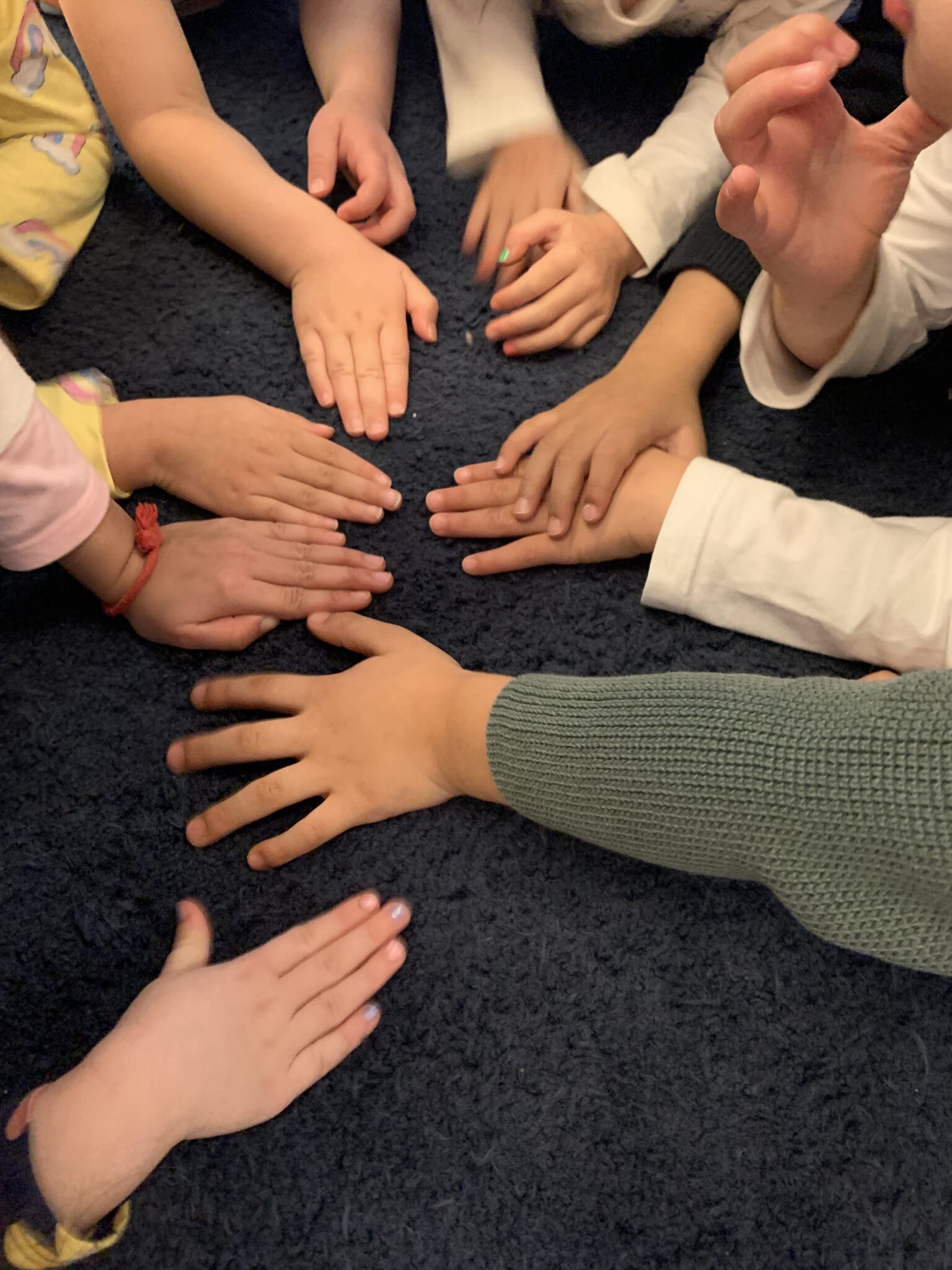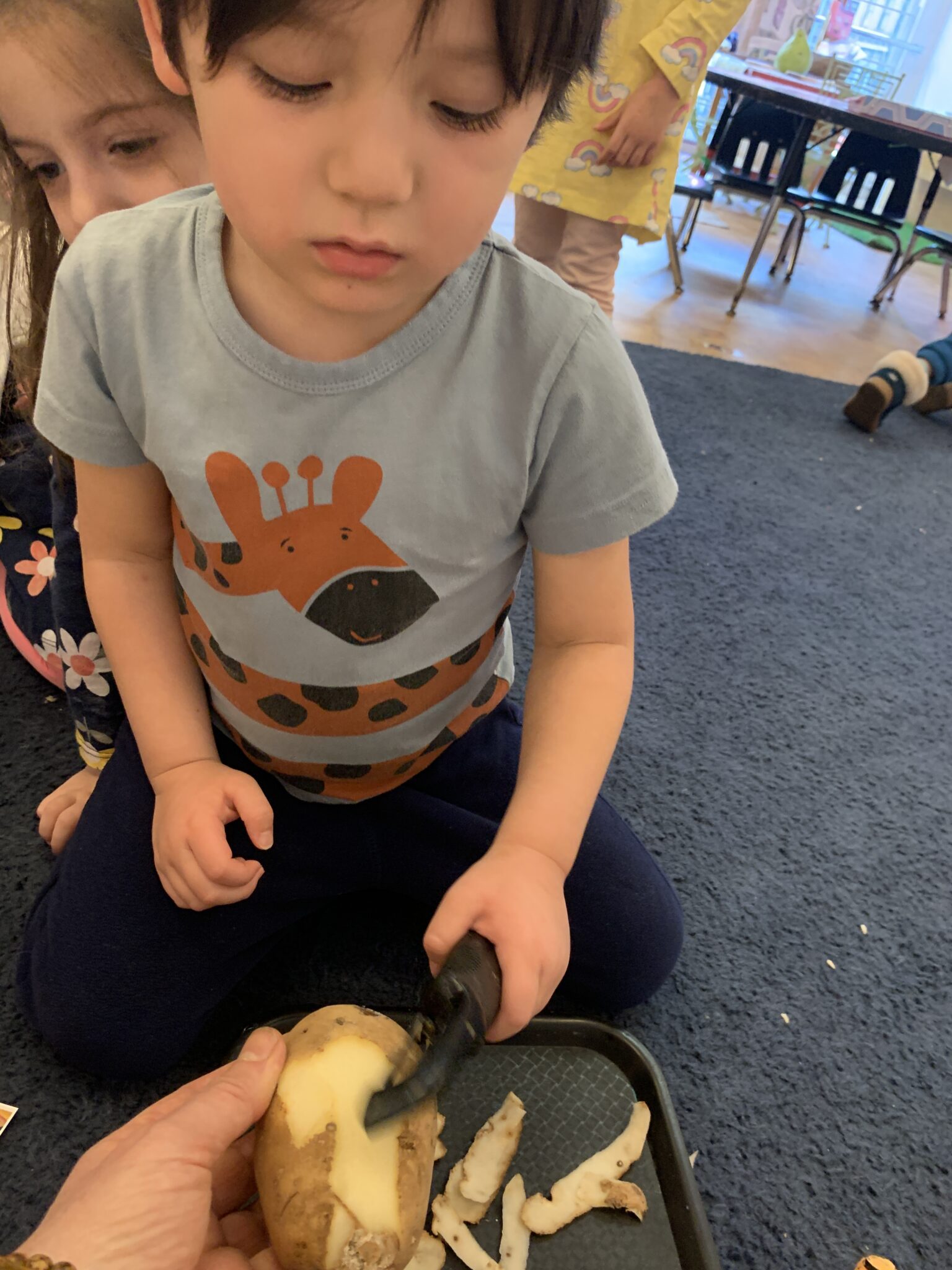Written by: Lynn Barkhorn – 3's Head Teacher
In classroom 7, the interest in skin color emerged when we first began playing our "Can you guess the baby?" game. We've been playing this game as a group during our meetings.

The first baby picture we shared was Sophie's. Knight guessed it was Sophie right away. A teacher asked him how he knew it was Sophie; he said, "I don't know." Stacy jumped in and said, "That's Sophie's skin. My skin is whiter." Children were then asked to look at their own and their friend's skin. All agreed that our skin is a range of shades. Mica added, "I was born with this skin." Yes! We are all born with skin in all kinds of shades. William added, "I have dead skin." William could not find his dead skin. Lynn found some by her fingernail that she shared. Everyone thought it looked familiar and agreed they sometimes have dead skin, too.
It's always exciting during our meetings when something spontaneously sparks children's interest, and they all want to say something at once. Here are some thoughts about skin we were able to document:
Mica – I think mine matches Avyaan's. Avyaan – Me and Hugo match. Avyaan – Mine is a little darker. Sophie – Avyaan look – we're both wearing the same color. William – It's hard to change skin into something else. I can press it here and it changes. (He pressed his finger onto his hand).
We all tried William's idea, pressing hard with one finger onto a body part, and sure enough, our skin turned lighter, then quickly returned to its original shade.
Knight – Mine matches Avyaan. Hugo – Mine matches like Mica. Ronan – Our skin comes from the food we eat.
This conversation affirmed that we all have the skin we are born with. Our skin is different shades. We made a plan to continue our skin conversation and investigate some more the following day. Children then continued the guessing game using skin color as one clue.
We revisited our skin conversation the following day. On this day, we began by reading All the Colors We Are – The Story of How We Got Our Skin Color by Katie Kissinger. Talking about skin shades through the lens of science helps children understand the facts about skin tones. The book tells us we all have melanin in our skin. The darker skin is, the busier the melanin is; the lighter skin is, the less busy melanin is. The book tells us how the sun makes our melanin busier when we are in hot sun, so we are protected from sunburn. This is why our skin gets darker from the sun. Stacy said she is going to Florida soon, and her skin will probably get darker. We thought it could be fun to invite families who might travel to hot and sunny locations, if they would like, to take a photo of a tan line or a before and after photo that we can share with the class! Melanin is amazing!
In the meantime, we discovered that zebras' and tigers' stripes (and more) are due to busy melanin! And foods have melanin, too! On Thursday, we peeled apples and potatoes and left them out overnight to see if their melanin would get busy in the sun. The next day, William noticed the potato on his way to our morning gathering on the rug and announced: "The melanin is so busy!" Avyaan added, "But my melanin is busy!" Knight, referring back to the potato, said, "It's getting busier." It's true! The melanin got really busy once it was in the light, and the apple and potato skin did not shield it from the light. And it's true Avyaan's melanin is busy! We all agreed the potato's melanin was busier than the apples. You can see below – our potato on the right had very busy melanin – this is with the skin off!

Talking about our skin tones can cause us adults to feel unsure about how to respond. And it's super important that we do respond. Here are a few links to articles that we have found helpful, and you may too.



*Children are Not Colorblind *How To Discuss Diverse Skin Tones With Young Children
If you would like more resources at any point, we are always happy to share.
The book we read together also says our skin color comes from our ancestors. Usually, if your ancestors are from a hot, sunny place, your skin is darker, and if your ancestors are from a place further from the sun, your skin is lighter. Mica asked, "What are ancestors?" We talked a little bit about what ancestors are. On Friday, we read a book, Stand Tall Molly Lou Melon, by Patty Lovell. In the end, we meet Molly Lou Melon's ancestor – her grandmother. We noticed that Molly Lou's melanin is similar to that of her ancestor, grandmother. We also talked a bit about how people can be in the same family and have different ancestors. In Lynn's family, her daughter was adopted, so they have different ancestors. We looked at a picture of Lynn's daughter, whose ancestors are from places that are hot and sunny. We compared Lynn's skin next to her daughters, everyone guessed that her daughters' melanin was much busier than Lynn's.

This has been an important conversation for our class as we build awareness of ourselves and our community. Talking about the differences and similarities of skin color as science removes the social construct of race and teaches children the simple facts about our skin shades. In the words of Britt Hawthorne, "Discussing skin tones are simple biology lessons. Skipping over these lessons does not lend to young children's need for understanding the world around them – or even understanding themselves." And so we begin there, with science.



Lastly, children were really excited to look at their skin and find a paint chip that they felt matched their skin. It was really a challenge! There are SO many shades, and none quite match exactly. If you happen by a paint store this weekend, feel free to bring in some more shades next week! We'd love to do some exploration with all the beautiful shades of brown.

